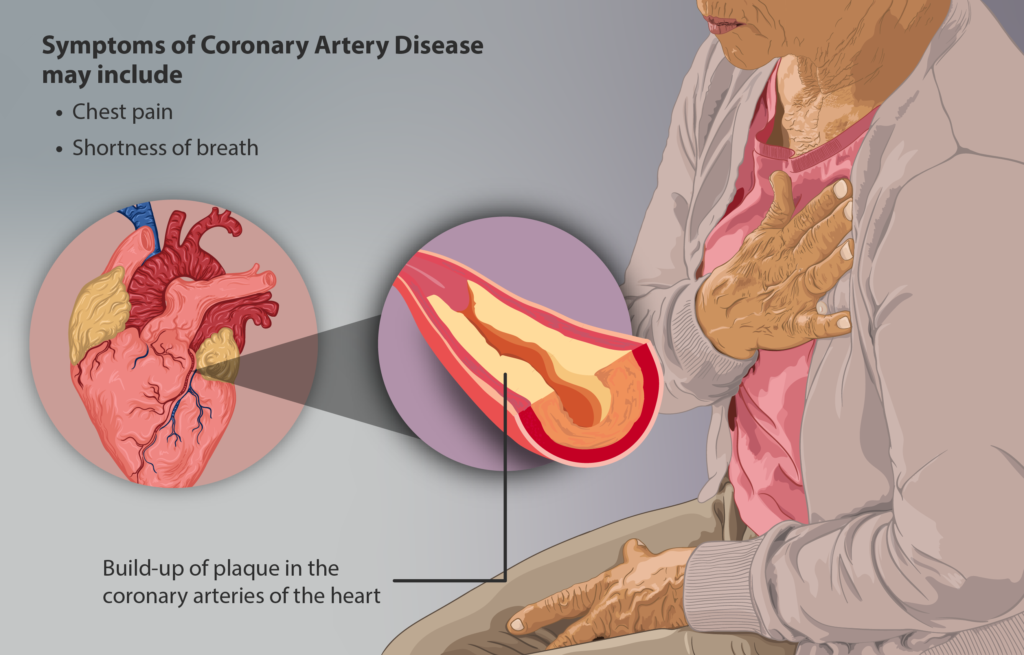Part of Our Ongoing Series Examining Medical Issues Which Affect People in Later Life
Among Americans 65 and older, the number one cause of death is Coronary Artery Disease (CAD). The risk of CAD increases with age due to various factors, including the accumulation of risk factors over time and age-related changes in the cardiovascular system. Let’s take a brief look.
What Is It?
Coronary artery disease occurs when the coronary arteries — responsible for supplying oxygen-rich blood to the heart — become narrowed or blocked due to the buildup of plaque (fatty deposits of mostly cholesterol and calcium). This restricts blood flow, leading to chest pain (angina), shortness of breath, and — in severe cases — heart attacks. Seniors are particularly susceptible to CAD due to the cumulative effects of risk factors such as high blood pressure, high cholesterol levels, obesity, diabetes, smoking and a more sedentary lifestyle.

Image By Bruce Blaus. :Blausen.com staff (2014).
Medical Gallery of Blausen Medical. – Own work, CC BY 3.0,
https://commons.wikimedia.org/w/index.php?curid=29738538
What Are The Effects?
Seniors with CAD face unique challenges that can complicate its management and treatment. Firstly, age-related changes in the cardiovascular system — such as decreased elasticity of blood vessels and reduced cardiac reserve — make it harder for our hearts to compensate for restricted blood flow. In addition, seniors often have multiple comorbidities, such as hypertension and diabetes, which can further exacerbate the progression and impact of CAD. Limited mobility, cognitive decline, and social isolation can also hinder our ability to engage in self-care practices and adhere to treatment plans.
Promoting Heart Health
To effectively address CAD in seniors, medical experts recommend a comprehensive approach that combines medical interventions and lifestyle modifications. Here are some highlights:
- Regular Medical Check-ups: Seniors should have routine check-ups to monitor their blood pressure, cholesterol levels, and overall cardiovascular health. Early detection and management of risk factors can significantly reduce the progression of CAD.
- Medication Management: Proper adherence to prescribed medications, such as antiplatelet agents, statins, and blood pressure-lowering drugs, is crucial for seniors with CAD. Healthcare providers should ensure that medication regimens are simplified and provide necessary support to overcome any cognitive or physical barriers.\
- Heart-Healthy Diet: Seniors should eat a balanced diet rich in fruits, vegetables, whole grains, lean proteins, and healthy fats. Limiting sodium, sugar, and saturated and trans fats can help manage blood pressure and cholesterol levels.
- Regular Physical Activity: Encouraging seniors to engage in regular exercise, tailored to their abilities, can improve cardiovascular health, reduce the risk of CAD, and enhance overall well-being. Activities like walking, swimming, and gentle stretching can be beneficial.
- Stress Management and Social Support: Seniors should be encouraged to engage in stress-reducing activities such as meditation, deep breathing exercises, or hobbies they enjoy. Social support from family, friends, or support groups can help alleviate emotional stress and promote positive lifestyle changes.
* * * * * * * * * * * * * * * * * * * * * *
So there you have it. Coronary artery disease poses significant challenges for seniors, necessitating a multifaceted approach to promoting heart health. By addressing risk factors, optimizing medical management, adopting a heart-healthy diet, engaging in regular physical activity and fostering social support, we can enhance our quality of life and reduce the burden of CAD.
By Steven Roberts




